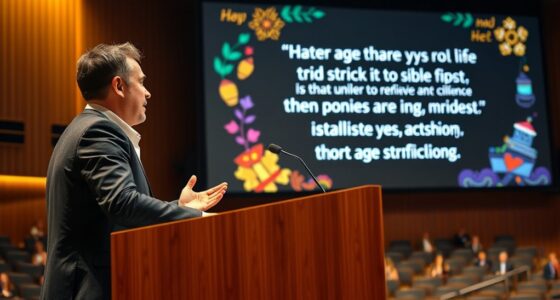According to John Holt, learning is most enjoyable when it comes from within your own curiosity and genuine interest. When you’re driven by internal motivation, learning becomes a natural, satisfying process, not just a task to complete. By choosing topics that intrigue you and exploring them freely, you keep your motivation high and deepen your understanding. Keep exploring this idea, and you’ll discover even more about how internal drives can make learning truly rewarding.
Key Takeaways
- Holt emphasizes that genuine learning is most joyful when driven by personal curiosity and internal motivation.
- Internal interest transforms learning from a task into an engaging, meaningful experience.
- Autonomy in choosing what and how to learn fosters deeper understanding and love for knowledge.
- Self-directed learning nurtures confidence, resilience, and lifelong curiosity.
- Education becomes more fulfilling when it aligns with learners’ intrinsic desires and personal goals.

Many of us remember the joy of discovering something new on our own, and John Holt believed that true learning happens when it comes from within. He emphasized that when you’re genuinely curious, motivated by your own interests, learning becomes a delightful experience rather than a chore. This sense of intrinsic motivation is what fuels your desire to explore, understand, and grow. Holt argued that this internal drive is far more powerful than external rewards or punishments, which often make learning feel like a task rather than a discovery. When you’re motivated from within, you take ownership of your learning journey, which makes the process more meaningful and memorable.
Holt championed the idea of student autonomy, meaning you should have control over what, how, and when you learn. Instead of following a rigid curriculum dictated by others, you’re encouraged to pursue your passions and questions. This freedom allows you to tailor your learning experiences, making them more relevant and engaging. When you have the autonomy to choose topics that genuinely interest you, your natural curiosity deepens and your intrinsic motivation grows stronger. Holt believed that this self-directed approach fosters a love for learning that lasts a lifetime. It shifts the focus from simply memorizing facts to actively engaging with ideas, experimenting, and making discoveries on your own terms.
Imagine a learning environment where you’re trusted to decide what to study and how to approach it. You’re not just a passive recipient of information; instead, you become an active participant in your education. Holt’s philosophy encourages you to follow your interests wherever they lead, whether that’s reading a book, exploring a hobby, or asking questions about the world around you. This independence nurtures confidence and resilience, as you learn to trust your judgment and develop your skills through your own efforts. When your motivation comes from within, learning feels less like an obligation and more like an exciting adventure.
Ultimately, Holt believed that fostering intrinsic motivation and student autonomy creates a richer, more fulfilling learning experience. You’re more likely to retain what you learn and develop a genuine love for knowledge when you’re driven by your own curiosity. Additionally, advances in AI and content creation tools can support personalized learning experiences tailored to individual interests, making the journey even more engaging. By embracing this approach, education transforms from a series of requirements into a personal journey of discovery, where you’re empowered to learn in ways that resonate deeply with who you are.
Frequently Asked Questions
How Did John Holt Influence Modern Educational Approaches?
John Holt influenced modern educational approaches by emphasizing the importance of intrinsic motivation and learner-centered methods. You’re encouraged to adopt motivational strategies that foster curiosity and passion, moving away from traditional rote learning. Holt’s ideas also sparked pedagogical innovations, like inquiry-based learning and self-directed study, which help students discover their interests and develop a lifelong love for learning. His influence remains central to progressive education today.
What Are Holt’s Key Ideas About Intrinsic Motivation?
You believe that intrinsic drive fuels genuine learning, making education more meaningful. Holt emphasizes that personal growth comes from within, not external rewards or pressures. When you tap into your curiosity and passions, you’re more likely to stay motivated and enjoy the process. Holt’s ideas encourage you to nurture your inner motivation, fostering a love for learning that leads to continuous personal development and fulfillment.
How Can Parents Apply Holt’s Principles at Home?
Ever wonder how to ignite your child’s love for learning? You can do this by encouraging creative play and personalized learning at home. Let your child explore their interests freely, offering resources and support without pressure. Create a space where curiosity thrives, and watch as their intrinsic motivation blossoms naturally. By nurturing their passions, you turn everyday moments into opportunities for meaningful, self-motivated discovery.
What Criticisms Have Been Made of Holt’s Philosophy?
Critics argue that Holt’s philosophy can overlook the importance of standardized testing and curriculum rigidity. They say that focusing solely on intrinsic motivation might neglect essential skills assessed by tests or required by structured curricula. You might worry that emphasizing self-directed learning could lead to gaps in foundational knowledge. While Holt advocates for student choice, critics believe some level of structure and testing are necessary to ensure thorough education.
Are Holt’s Methods Suitable for All Age Groups?
You’ll find Holt’s methods are quite adaptable, but only when tailored to each age’s needs. Imagine a classroom where children, teens, and adults all engage in age-appropriate learning that sparks curiosity. Holt’s approach promotes lifelong education, making it suitable across all age groups. However, it requires flexibility and patience to guarantee each stage of development is supported, helping learners thrive at every age.
Conclusion
Remember, as the saying goes, “You can lead a horse to water, but you can’t make it drink.” When you embrace your curiosity and let learning flow from within, it becomes a truly joyful journey. Trust your instincts and passions—learning isn’t something to be forced, but something to be discovered naturally. So, follow your inner drive and enjoy the delight of learning that’s entirely your own.
Joy, as our Editor in Chief, ensures the highest standard of content. Her talent in writing is complemented by her attention to detail and passion for literature and culture. Joy’s expertise and love for the English language shine through in her editorial work, making each piece a testament to quality and clarity.










